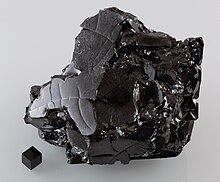Vitreous carbon

Vitreous carbon , also called vitreous carbon , is a synthetic material made of pure carbon that combines vitreous ceramic properties with those of graphite .
properties

Vitreous carbon has a high temperature resistance under protective gas or in a vacuum up to over 3000 ° C, extreme corrosion resistance , liquid and gas tightness (He permeability 10 −9 to 10 −11 cm² / s), no wetting by melting, high hardness ( HV 250–350 ) and strength (flexural strength around 250 MPa, stiffness around 35 GPa), low density (1.4–1.5 g / cm³), high surface quality , low thermal expansion (around 2.5 × 10 −6 1 / K between 20 and 2000 ° C), extreme thermal shock resistance , moderate thermal (4-6 W / (K · m) at 20 ° C) and electrical conductivity (2 × 10 4 1 / (Ω · m)), isotropy of the physical and chemical properties and good biocompatibility .
Electronically, vitreous carbon is one of the semiconductors with a small energy band gap. Vitreous carbon is a form of carbon with a highly disordered graphite structure that is produced from the pyrolysis of polymers. With the structure of the polymers, vitreous carbon has its own typical microstructure from the cradle. Only the level of the pyrolysis temperature then determines the degree of graphitic components in the material. The carbon atoms with sp 2 bond are arranged in planes with hexagonal symmetry. The TEM image shows crystallites of graphene layers that enclose small pores with a size of around 1 nm. The electron microscope only shows the basal planes that are oriented in the direction of the electron beam.
The model illustrates the microstructure of vitreous carbon. The bars consist of graphite crystallites with a layer thickness of 4 to 10 basal planes. In contrast to activated carbon , the pores are not connected to one another. The spread in the size of the closed pores is small. Depending on how it is manufactured, it is around 1–5 nm. Macroscopically, vitreous carbon appears isotropic. The model explains the low density compared to graphite, the high hardness and strength and the isotropy of the material parameters.
Due to the high hardness, mechanical processing is only possible with diamond tools. Alternative machining methods are spark erosion (EDM), water jet cutting or laser cutting .
use
Vitreous carbon is used as an electrode material for electrochemical applications due to its good electrical conductivity and chemical stability . With the help of polishing agents based on diamond or corundum particles , the surface can be easily renewed, which allows the material to be reused.
See also
Web links
- Peter Harris, Fullerene-related structure of commercial glassy carbons (English; PDF; 1.5 MB)
Individual evidence
- ↑ PJF Harris †: Fullerene-related structure of commercial glassy carbons . In: Philosophical Magazine . tape 84 , no. 29 , October 11, 2004, ISSN 1478-6435 , p. 3159-3167 , doi : 10.1080 / 14786430410001720363 .
- ↑ a b Kawamura, K. (Kiyoshi), 1942-: Polymeric carbons - carbon fiber, glass and char . Cambridge University Press, Cambridge 1976, ISBN 0-521-20693-6 .
- ↑ Miloslav Kopanica, František Vydra: Voltammetry with disc electrodes and its analytical application . In: Journal of Electroanalytical Chemistry and Interfacial Electrochemistry . tape 31 , no. 1 , June 1971, p. 175-181 , doi : 10.1016 / S0022-0728 (71) 80055-4 .
